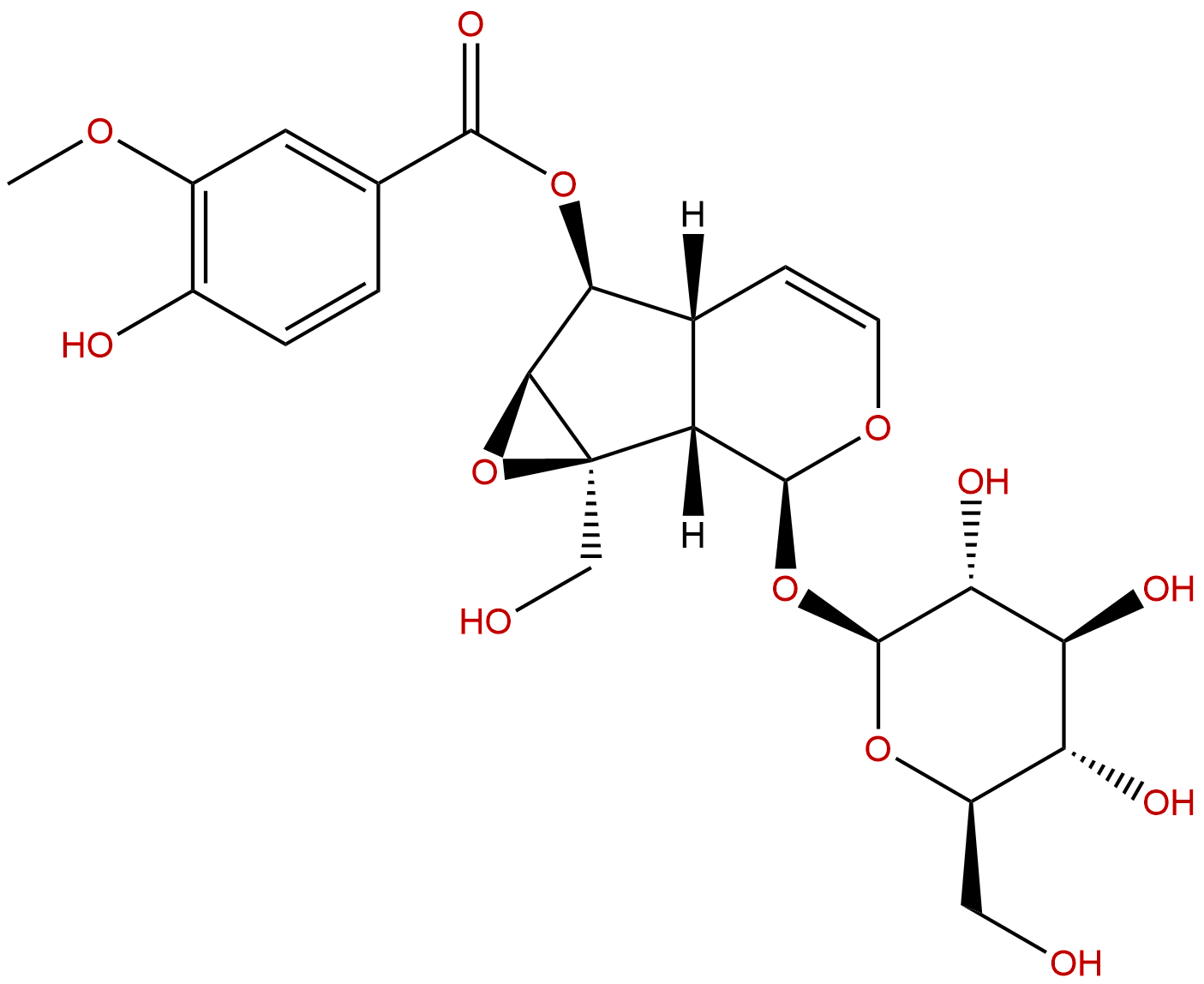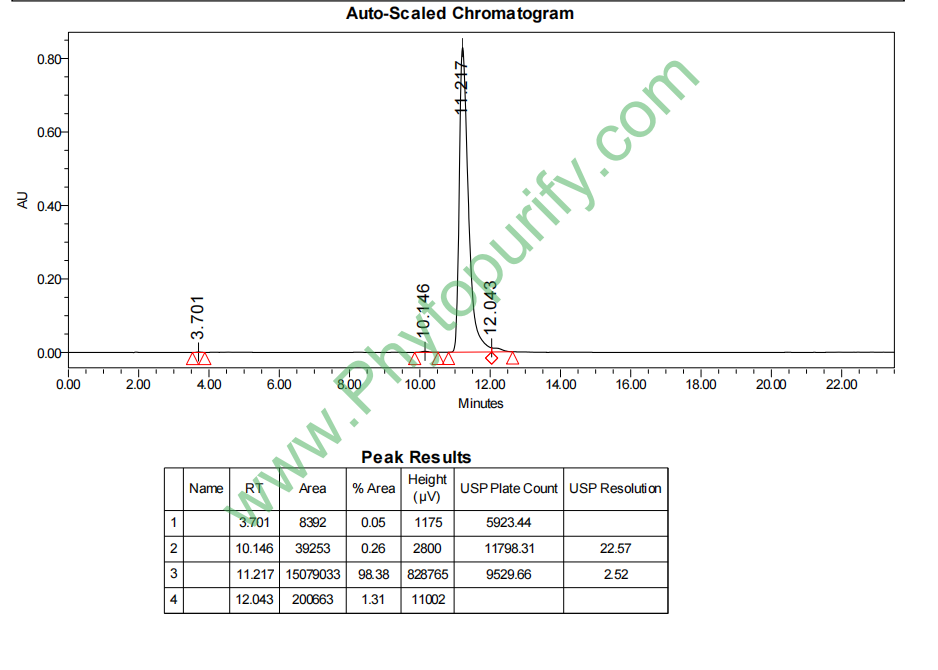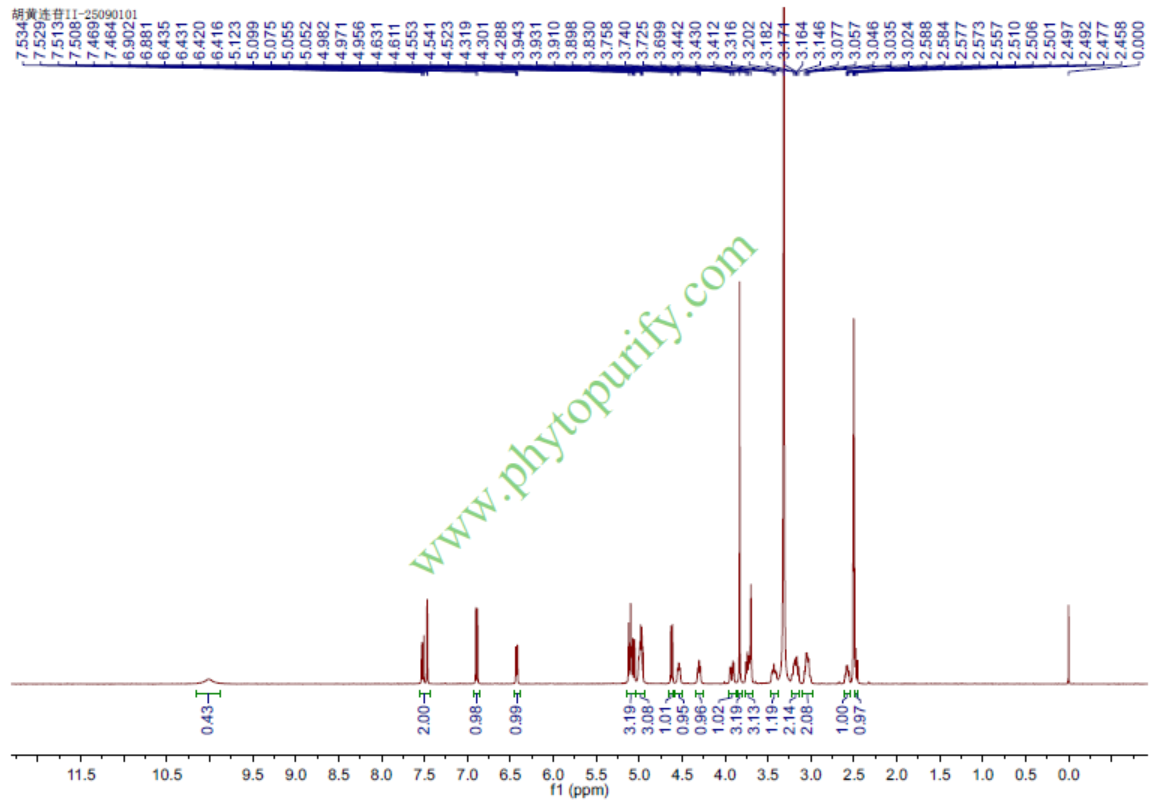
Picroside IICAS No.:39012-20-9
|
||||||||||
 |
|
|
||||||||

| Catalogue No.: | BP1100 |
| Formula: | C23H28O13 |
| Mol Weight: | 512.464 |
Product name: Picroside II
Synonym name: Amphicoside; Vanilloyl catalpol
Catalogue No.: BP1100
Cas No.: 39012-20-9
Formula: C23H28O13
Mol Weight: 512.464
Botanical Source: Picrorhiza scrophulariiflora Pennell
Physical Description:
Type of Compound: Iridoids
Purity: 95%~99%
Analysis Method: HPLC-DAD or/and HPLC-ELSD
Identification Method: Mass, NMR
Packing: Brown vial or HDPE plastic bottle
Storage: Store in a well closed container, protected from air and light. Put into refrigerate or freeze for long term storage.
Whenever possible, you should prepare and use solutions on the same day. However, if you need to make up stock solutions in advance, we recommend that you store the solution as aliquots in tightly sealed vials at -20℃. Generally, these will be useable for up to two weeks.
The product could be supplied from milligrams to grams
Inquire for bulk scale.
Description:
Picroside II has antioxidant, anti-inflammatory, immune regulatory, anti-virus and other pharmacological activities. It has potent anti-apoptotic activity against renal I/R injury by suppressing the TLR4/NF-κB signaling pathway, it can protect the ischemic kidney against renal fibrosis and improve the neurological function of rats upon cerebral ischemia reperfusion injury. Picroside II enhances nerve growth factor (NGF)-induced neurite outgrowth from PC12D cells by amplifying a down-stream step of MAP kinase in the NGF receptor-mediated intracellular MAP kinase-dependent signaling pathway.
References:
Acta Pharmacol Sin. 2005 Jun;26(6):729-36.
Inhibitory effect of picroside II on hepatocyte apoptosis.
To investigate the influence of Picroside II on hepatocyte apoptosis and its mechanism.
METHODS AND RESULTS:
Morphological changes and quantification of apoptotic cells were determined under transmission electron microscopy and flow cytometry respectively. DNA fragmentation was visualized by agarose gel electrophoresis. Semi-quantitative reverse transcription-PCR (RT-PCR) was used to analyze the expression of bcl-2 and bax genes. The content of manganese-superoxide dismutase (SOD) in liver mitochondria was detected by the Marland method. The content of malonic aldehyde (MDA) and the protein level in liver tissue were determined by thiobarbituric acid colorimetry and Lowry method. Picroside II decreased the levels of alanine aminotransferase and aspartate aminotransferase in the serum resulting from acute-liver injured mice induced with D-GalN and LPS; it also reduced the content of MDA, and thus, enhanced the activity of SOD. Picroside II 10 mg/kg was found to protect hepatocytes against apoptosis in a dose-dependent manner; it up-regulated the expression of bcl-2 genes, thus increased the bcl-2/bax ratio.
CONCLUSIONS:
Picroside II can protect hepatocytes against injury and prevent hepatocytes from apoptosis. It might by upregulating the bcl-2 gene expression and antioxidation.
Exp Ther Med. 2015 Apr;9(4):1253-1258.
Picroside II protects rat kidney against ischemia/reperfusion-induced oxidative stress and inflammation by the TLR4/NF-κB pathway.
Picroside II possesses a wide range of pharmacological effects and has been demonstrated to ameliorate cerebral ischemia and reperfusion (I/R) injury. However, its effects on renal I/R injury remain unclear. In the present study, the role of Picroside II in attenuating oxidative stress and the inflammatory response in a rat model of renal I/R injury was investigated.
METHODS AND RESULTS:
Sprague Dawley rats were subjected to 45 min of ischemia followed by 24 h of reperfusion. Prior to reperfusion, the rats were treated with Picroside II or an equal volume of phosphate-buffered saline. Renal function and histological changes were compared and the relevant parameters of oxidative stress and inflammation were detected. The expression of toll-like receptor 4 (TLR4) and nuclear factor κB (NF-κB; p65) were assessed by immunohistochemistry and western blotting. It was observed that renal function was significantly improved by treatment with Picroside II. Morphological analysis indicated that Picroside II clearly reduced tissue damage and the expression of TLR4 and NF-κB. Reverse transcription-quantitative polymerase chain reaction demonstrated that Picroside II inhibited the increase of tumor necrosis factor (TNF)-α, interleukin (IL)-1β and intercellular adhesion molecule (ICAM)-1 expression induced by I/R injury. Western blot analysis indicated that the expression levels of TLR4 and NF-κB were significantly downregulated in the Picroside II group compared with those in the I/R group.
CONCLUSIONS:
These results indicate that Picroside II treatment suppressed the TLR4/NF-κB signaling pathway, protecting renal tissue against I/R-induced oxidative stress and inflammatory response.
Int J Mol Sci. 2010 Nov 16;11(11):4580-90.
Neuroprotective properties of picroside II in a rat model of focal cerebral ischemia.
The aim of this study was to explore the effect of Picroside II on neuronal apoptosis and the expression of caspase-3 and poly ADP-ribose polymerase (PARP) following middle cerebral artery occlusion/reperfusion in male Wistar rats.
METHODS AND RESULTS:
Picroside II (10 mg/kg) was administered intravenously into the tail vein of the animals. The neurological function deficits were evaluated with the Bederson's test and the cerebral infarction volume was visualized with tetrazolium chloride (TTC) staining. The apoptotic cells were counted by in situ terminal deoxynucleotidyl transferase-mediated biotinylated deoxyuridine triphosphate nick end labeling (TUNEL) assay. The immunohistochemistry stain and enzyme linked immunosorbent assay (ELISA) was used to determine the expressions of caspase-3 and PARP in brain tissue. The results indicated that rats in the control group showed neurological function deficit and cerebral infarction in ischemic hemisphere after two hours ischemia followed by 22 hours reperfusion. Caspase-3 and PARP expressions were also profound in the cortex, the striatum and the hippocampus, along with increased apoptotic cells in this group. Bederson's score, infarction volume, and expressions of caspase-3 and PARP, as well as apoptosis in the treatment group were,however, significantly decreased compared to those in the control group .
CONCLUSIONS:
Indicating that intravenous treatment with Picroside II might be beneficial to inhibit neuronal apoptosis and, thus, to improve the neurological function of rats upon cerebral ischemia reperfusion injury.
Modern Research in Inflammation, 2013, 02(3):46-53.
The anti-inflammatory effect of picroside II and the optimizing of therapeutic dose and time window in cerebral ischemic injury in rats
The aim is to optimize the anti-inflammatory effect and the therapeutic dose and time window of picrosede II by orthogonal test in cerebral ischemic injury in rats.
METHODS AND RESULTS:
The forebrain ischemia models were established by bilateral common carotid artery occlusion (BCCAO) methods in 30 Wistar rats. The successful models were randomly divided into sixteen groups according to orthogonal experimental design and treated by injecting Picroside II intraperitoneally at different ischemic time with different dose. The concentrations of aquaporins 4 (AQP4), matrix metalloproteinases9 (MMP9) and cyclooxygenase 2 (COX2) in serum and brain tissue were determined by enzyme linked immunosorbent assay to evaluate the therapeutic effect of Picroside II in cerebral ischemic injury. The best therapeutic time window and dose of Picroside II in cerebral ischemic injury were 1) ischemia 2.0 h with 20 mg/kg and 1.5 h with 20 mg/kg body weight according to the concentration of AQP4 in serum and brain tissue; 2) ischemia 1.5 h with 20 mg/kg and ischemia 2.0 h with 20 mg/kg according to the concentrations of MMP9 in serum and brain tissue; and 3) ischemia 1.5 h with 10 mg/kg and ischemia 1.5 h with 20 mg/kg according to the concentrations of COX2 in serum and brain tissue respectively. According to the principle of the lowest therapeutic dose with the longest time window, the optimized therapeutic dose and time window were injecting Picroside II intraperitoneally with 10 - 20 mg/kg body weight at ischemia 1.5 - 2.0 h in cerebral ischemic injury.
HPLC of Picroside II

HNMR of Picroside II
